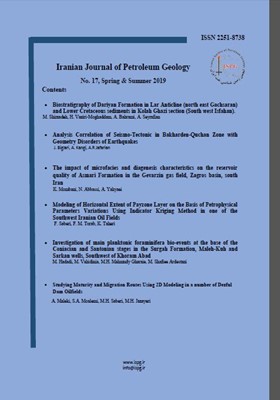Biostratigraphy of Dariyan Formation in Lar Anticline (north east Gachsaran) and Lower Cretaceous sediments in Kolah Ghazi section (South west Isfahan)
Subject Areas : Geoscience Fields in relation with Petroleum GeologyMahdie Shirzad 1 , Hosyen Vaziri moghadam 2 , Ali Bahrami 3
1 - دانشگاه اصفهان
2 - دانشگاه اصفهان
3 - دانشگاه اصفهان
Keywords: Dariyan Formation Lar Anticline Cretaceous sediments Kolah Ghazi Biostratigraphy Biozone ,
Abstract :
In order to identify foraminifera and determine the age of Dariyan Formation and the lower Cretaceous sediments of Central Iran, a section of Dariyan Formation in Lar Anticline (northeast Gachsaran) (with a thickness of 111m, thick, medium and thin layer of limestone, marl and marly limestone) and Kolah Ghazi section (south west Isfahan) (with a thickness of 260m, thick to medium layer limestone and shale) were studied. Based on biostratigraphic studies of Lar Anticline section, 28 benthonic foraminifera and 4 planktonic foraminifera have been identified in 4 biozones contains: Hedbergellids - Orbitolinids assemblage zone, Mesorbitolina texana zone, Mesorbitolina gr. subconcava zone, Favusella washitensis rang zone. Based on biostratigraphic of Lower Cretaseous sediments in Kuh-e-Kolah Ghazi, 21 benthonic foraminifera and 1 planktonic foraminifera have been identified and consequently 2 biozones are recognized contains: Mesorbitolina texana zone, Mesorbitolina gr. subconcava zonethe studied areas were correlated with some sections of the Dariyan in Kuh-e-Fahliyan, Kuh-e- Mangasht and Meymand. Accordingly, the sedimentation of two studied sections in Lar Anticline and Kuh-e-Kolah Ghazi were started from Late Aptian which were later than the other sections, and the end of sedimentation in the Kuh-e-Kolah Ghazi was earlier than the other sections in the Late Aptian age, while the end of sedimentation of Dariyan Formation in other sections was in Early Albian age

